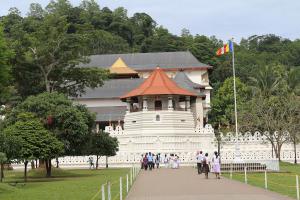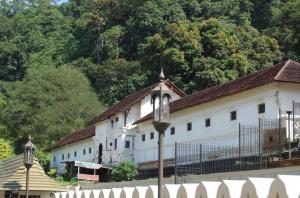Vimaladharmasuriya I, also known as Konappu Bandara before Coronation and Dom Joan of Austria or Don Jhon Appuhamy, was a king of Sri Lanka who ruled the country from 1590 to 1604. He was a late 16th-century to early 17th-century king of the Kandyan Kingdom, located in the central hills of the present-day island nation of Sri Lanka. His reputation was built when he successfully repulsed two major Portuguese offensives in to Kandy. In 1594 the battle of Danture and in 1602 the Battle of Balana, in both of which the Portuguese had a humiliating defeat.
King Vimaladharmasuriya is regarded by some historians as the Kandyan Kingdom's second founder, responsible for its revival. Born Konnappu Bandara, he was baptized under the Portuguese name of Don João da Austria. In 1594 he married Princess Kusmasana Devi who, as Dona Catherina, was put forward by the Portuguese as the rightful claimant to the throne and became king. After renouncing Christianity and embracing Buddhism, Vimaladharmasuriya constructed a two-tiered shrine close to his palace in order to sanctify his capital Kandy and accommodate the politically important relic known as Buddha’s Tooth.
The Dutch explorer Joris van Spilbergen offered an alliance to fight off the Portuguese. Following these negotiations, Sebald de Weert was sent officially by Admiral Wybrand van Warwijck to mount a joint counter-attack against the Portuguese. The alliance ended in disaster however during a drinking party, where the Dutch became rowdy, De Weert according to François Valentijn insulted the queen, and De Weert and all 47 Dutchmen accompanying him consequently were killed. An alliance would not be possible again until 1612, when a new Dutch envoy, Marcellus de Boschouwer, established a treaty with King Senarat, ultimately leading to the eviction of the Portuguese from the island, and about one century of Dutch rule, until the British in turn took the island.
At the time of his coronation Buddhism was on the verge of disappearing from the island. The king learned that ordained Buddhist monks no longer existed on the island so he sent one of his ministers to Southern Burma and reestablished Buddhism in the island. By this time the Relic of the tooth of the Buddha was hidden in Delgamuwa vihara in Sabaragamuwa province. The king brought the Tooth relic to Kandy and built a two storied Temple near the royal palace to house the relic. He also repaired many ruined Buddhist temples throughout his kingdom.



